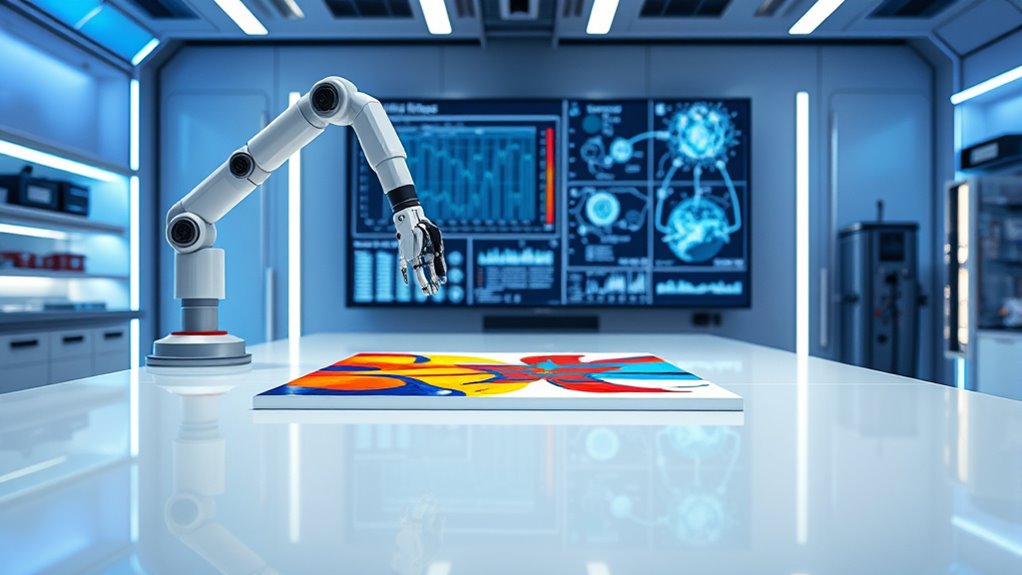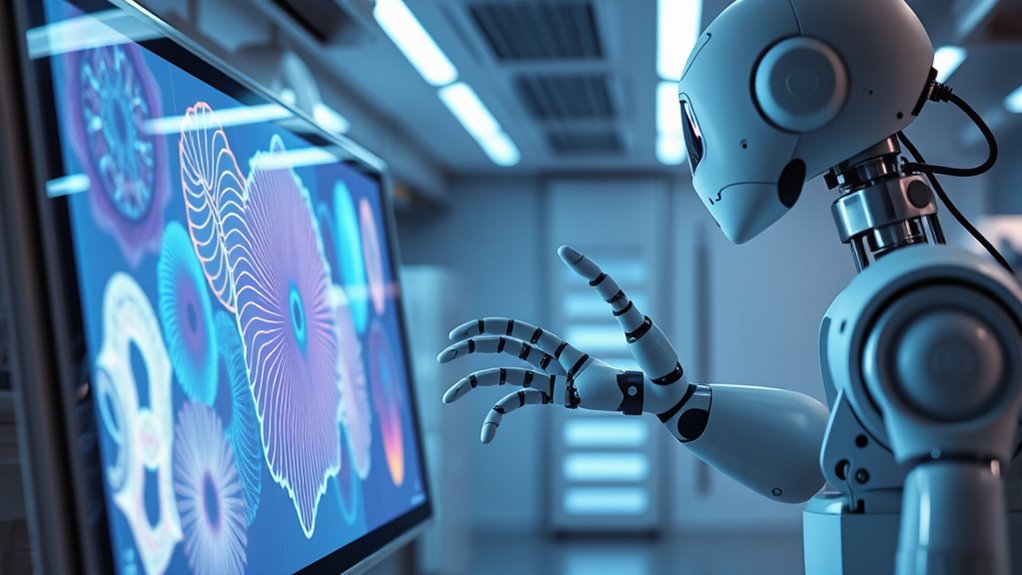Machines are starting to understand your aesthetic preferences by analyzing visual features like color, composition, and symmetry, which help predict what you find appealing. They use advanced algorithms, including deep neural networks, to interpret complex cues and learn individual tastes even with limited examples. By leveraging large datasets and non-linear models, machines can personalize their predictions and adapt over time. Keep exploring to discover how these technologies are shaping our perceptions of beauty and style.
Key Takeaways
- Machine learning models analyze visual features like color, composition, and emotional responses to predict human aesthetic preferences.
- Large datasets of human judgments enable training algorithms to rank and assess the attractiveness of images and 3D objects.
- Deep neural networks outperform traditional methods, capturing complex visual cues and individual taste variability.
- Personalized models quickly adapt to user preferences with minimal data, reflecting subjective aesthetic tastes.
- Geometric and visual features, combined with interpretable descriptors, help machines understand what drives aesthetic appeal.

Understanding aesthetic preferences in machines has become a fascinating area of research, as scientists explore how algorithms can predict human tastes in art and design. You might not realize it, but your subjective judgments about what looks good can be modeled using both simple and complex visual features. These features include basic visual properties like color and contrast, as well as more subjective aspects such as emotional response or personal meaning. Researchers have shown that these combined features can predict your preferences not only within your own choices but also across different people, using regression models that analyze these visual cues. Interestingly, deep neural networks trained for object recognition process features hierarchically, similar to how your brain might interpret images. These networks reveal that aesthetic valuation isn’t just a mystery; it can be systematically described and constructed from visual features. This means machines can, in a way, “understand” what makes an image appealing by analyzing its underlying properties, bridging the gap between raw visual input and human subjective judgment. Empirical datasets of human preferences have enabled the training of these models at large scales, making their predictions more accurate and reliable. Additionally, understanding how visual features influence preferences can help improve the design of algorithms that aim to emulate human aesthetic judgments.
When it comes to 3D shapes, researchers gather large datasets of human preferences through pairwise comparisons, enabling machines to rank objects based on aesthetic appeal. Features like symmetry, curvature, compactness, and proportionality are key drivers of what you find attractive. Non-linear machine learning models, such as Random Forests, better capture the complex interactions among these geometric features than simple linear models. By focusing on interpretable geometric descriptors, these models remain transparent, allowing you to understand why certain shapes are preferred. Cross-category analyses reveal that some aesthetic drivers are universal, while others are specific to particular objects, like chairs versus abstract sculptures.
For individual tastes, machine learning models can be trained on just a handful of curated images to predict your aesthetic preferences. These models adapt non-linearly, capturing your unique style with as few as 10 to 20 samples. Interactive methods that select images similar to your previous choices help refine these predictions more efficiently. This personalized approach allows machines to express subjective tastes that are often hard to verbalize, providing real-time updates as your preferences evolve. Deep learning models, especially convolutional neural networks, excel in predicting photo aesthetics, outperforming traditional algorithms and even human raters. They analyze complex visual cues like color harmony, composition, and sharpness, recognizing that individual preferences vary widely. As research advances, machines are becoming better at understanding what you find beautiful, making the interaction between human taste and machine prediction more seamless.
Frequently Asked Questions
Can Machines Truly Experience Aesthetic Pleasure?
No, machines can’t truly experience aesthetic pleasure. You might see AI generate beautiful images or music, but it does so through pattern recognition and algorithms, not feelings or consciousness. They lack subjective awareness, emotions, and sensory experiences that humans associate with aesthetic enjoyment. While they can mimic styles and predict preferences, they don’t genuinely feel pleasure or have personal meaning—making their “appreciation” fundamentally different from human aesthetic experience.
How Do Cultural Differences Influence Machine Aesthetic Understanding?
You should recognize that cultural differences shape how machines interpret aesthetic preferences. By analyzing neural responses and behavioral patterns across cultures, machines can learn to identify culturally specific attribute weights like color, complexity, and emotional expressiveness. Incorporating these cultural insights allows you to develop more adaptive algorithms that resonate with diverse aesthetic standards, making machine judgments more nuanced and contextually appropriate for different cultural audiences.
Are Machines Capable of Creative Aesthetic Judgments?
Yes, machines can make creative aesthetic judgments, but their understanding is limited. You see, they analyze visual features and predict preferences using complex models, explaining about 30% of human ratings. While they can mimic perceptual aspects of art, they lack deep semantic, emotional, and cultural insight. So, you should recognize that their judgments are based on pattern recognition rather than true creative understanding or subjective experience.
What Are the Limitations of Current Aesthetic Preference Algorithms?
You should recognize that current aesthetic preference algorithms face significant limitations. They rely on biased datasets, often favoring popular trends and ignoring minority or avant-garde styles. They lack nuance, struggle with subjective and emotional aspects, and can’t fully interpret context or personal experiences. Also, they tend to produce homogenized results, reducing diversity and creativity, and often fall short in capturing real-world dynamics that influence aesthetic judgment.
How Do Machines Adapt to Evolving Human Aesthetic Trends?
You’ll be amazed how machines keep up with your ever-changing style! They analyze massive social media streams, search data, and sales in real time, detecting subtle shifts before you even notice. By combining deep learning, trend forecasting, and human input, they adapt instantly to new aesthetics. This continuous feedback loop allows brands to craft designs that perfectly match your evolving tastes, making fashion more personalized, timely, and innovative than ever before.
Conclusion
As machines continue to refine their grasp of aesthetic preferences, they gently steer us toward new horizons of creativity and understanding. While they may seem to mirror our tastes, it’s more about opening subtle doors to possibilities we hadn’t fully explored ourselves. In this quiet dance between human intuition and machine insight, we’re invited to see beauty in fresh light—an understated reminder that sometimes, the most profound insights come when we least expect them.









